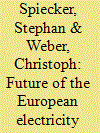|
|
|
Sort Order |
|
|
|
Items / Page
|
|
|
|
|
|
|
| Srl | Item |
| 1 |
ID:
127232


|
|
|
|
|
| Publication |
2014.
|
| Summary/Abstract |
Use of shallow geothermal energy, in terms of ground coupled heat pumps (GCHP) for heating and cooling purposes, is an environmentally-friendly and cost-effective alternative with potential to replace fossil fuels and help mitigate global warming. Focusing on the recent results of the GEO.POWER project, this paper aims at examining the energy performance strategies and the future regional and national financial instruments for large scale introduction of geothermal energy and GCHP systems in both residential and industrial buildings.
After a transferability assessment to evaluate the reproducibility of some outstanding examples of systems currently existing in Europe for the utilisation of shallow geothermal energy, a set of regulatory, economic and technical actions is proposed to encourage the GCHP market development and support geothermal energy investments in the frame of the existing European normative platforms. This analysis shows that many European markets are changing from a new GCHP market to growth market. However some interventions are still required, such as incentives, regulatory framework, certification schemes and training activities in order to accelerate the market uptake and achieve the main European energy and climate targets.
|
|
|
|
|
|
|
|
|
|
|
|
|
|
|
|
| 2 |
ID:
127207


|
|
|
|
|
| Publication |
2014.
|
| Summary/Abstract |
the ongoing transformation of the European energy system comes along with new challenges, notably increasing amounts of power generation from intermittent sources like wind and solar. How current objectives for emission reduction can be reached in the future and what the future power system will look like is, however, not fully clear. In particular, power plant investments in the long run and power plant dispatch in the short run are subject to considerable uncertainty. Therefore an approach is presented which allows electricity market development to be assessed in the presence of stochastic power feed-in and endogenous investments in power plants and renewable energies. To illustrate the range of possible future developments, five scenarios for the European electricity system up to 2050 are investigated. Both generation investments and dispatch as well as utilization of transmission lines are optimized for these scenarios and additional sensitivity analyses are carried out.
|
|
|
|
|
|
|
|
|
|
|
|
|
|
|
|
| 3 |
ID:
137683


|
|
|
|
|
| Summary/Abstract |
This paper presents the development of a bottom-up stock model to perform a holistic energy study of the Mexican non-domestic sector. The current energy and exergy flows are shown based on a categorisation by climatic regions with the aim of understanding the impact of local characteristics on regional efficiencies. Due to the limited data currently available, the study is supported by the development of a detailed archetype-based stock model using EnergyPlus as a first law analysis tool combined with an existing exergy analysis method. Twenty-one reference models were created to estimate the electric and gas use in the sector. The results indicate that sectoral energy and exergy annual input are 95.37 PJ and 94.28 PJ, respectively. Regional exergy efficiencies were found to be 17.8%, 16.6% and 23.2% for the hot-dry, hot-humid and temperate climates, respectively. The study concludes that significant potential for improvements still exists, especially in the cases of space conditioning, lighting, refrigeration, and cooking where most exergy destructions occur. Additionally, this work highlights that the method described may be further used to study the impact of large-scale refurbishments and promote national regulations and standards for sustainable buildings that takes into consideration energy and exergy indicators.
|
|
|
|
|
|
|
|
|
|
|
|
|
|
|
|
| 4 |
ID:
177435


|
|
|
|
|
| Summary/Abstract |
Developing countries are facing electrical energy shortage problems. These nations are adopting load shedding to protect their national grids from instabilities. In this research, load shedding is analyzed where customers opt for the use of uninterrupted power supplies (UPS) and store energy in batteries. It is found that Pakistan has wasted 7117 GWh of energy by charging and discharging the batteries of UPS by 26, 201, 910 residential and commercial customers of the country in 2018. The energy deficit of Pakistan can be reduced from 8.7% to just 1.5% by removing all UPS from the national grid. Several renewable alternatives such as photovoltaic (PV) systems, concentrated solar power plants, pump-hydro on dams, floating PV systems, wind turbines, and PV energy import from the Middle East have been suggested. Analytic hierarchy process is used for the selection of best city and best lake for PV and floating PV system respectively based on multivariable criteria. Pakistan overcame the gap between the electrical load demand and capability in 2019. A reduction of 77% in load shedding in Pakistan resulted in a dipping of load peak of 26 GW in 2018 to 25 GW in 2019. This drop-in load in 2019 is a direct result of the removal of 77% of UPS from the national grid. India, Sri Lanka, Nepal, and other developing countries can use this analysis to enhance their power systems.
|
|
|
|
|
|
|
|
|
|
|
|
|
|
|
|
| 5 |
ID:
110692


|
|
|
|
|
| Publication |
2011.
|
| Summary/Abstract |
The provision of adequate, reliable, and affordable energy has been considered as a cornerstone of development. More than one-third of the world's population has a very limited access to modern energy services and suffers from its various negative consequences. Researchers have been exploring various dimensions of household energy use in order to design strategies to provide secure access to modern energy services. However, despite more than three decades of effort, our understanding of household energy use patterns is very limited, particularly in the context of rural regions of the developing world. Through this paper, the past and the current trends in the field of energy analysis are investigated. The literature on rural energy and energy transition in developing world has been explored and the factors affecting households' decisions on energy use are listed. The and the factors affecting households' decisions on energy use are listed. The gaps identified in the literature on rural household energy analysis provide a basis for developing an alternative model that can create a more realistic view of household energy use. The three dimensional energy profile is presented as a new conceptual model for assessment of household energy use. This framework acts as a basis for building new theoretical and empirical models of rural household energy use.
|
|
|
|
|
|
|
|
|
|
|
|
|
|
|
|
| 6 |
ID:
149993


|
|
|
|
|
| Summary/Abstract |
Energy policy and research span multiple objectives, disciplines, methodologies, and data sets. This breadth of research results in conflicting analyses and proposals, which enable various parties to leverage these conflicts to further their vested interests. This paper explores these issues caused by differing research methodologies. It examines a recent proposal to search for common ground regarding contentious energy problems that emphasizes the use of different analytical frames as major sources of disagreement, and a case study regarding a dispute on how to conduct cost-benefit analyses of energy efficiency programs. Resolving differences among the research community and energy analysts requires a collaborative effort of painstaking research and debate. This paper articulates four policy implications. First, energy analysts should not be inexorably bound to their analytical frames. Second, analysts should not encroach on the role of policymakers by being asked to resolve questions that involve tradeoffs among fundamental values. Third, analysts have an important role helping to inform policymakers of the implications and limitations of various types of analyses of energy and environmental issues. Fourth, analysts need to develop a research program that is able to answer particular questions from multiple research frames in order to assess the robustness of their findings.
|
|
|
|
|
|
|
|
|
|
|
|
|
|
|
|
|
|
|
|
|